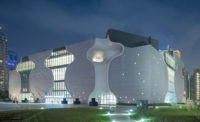Toyo Ito's National Taichung Theater on Display














Displaying architecture in a gallery is always a challenge. This is especially true with a building still under construction. And even more so when that building is Taiwan’s National Taichung Theater—unarguably Tokyo architect Toyo Ito’s most ambitious project to date. Taking Ito’s structural know-how and spatial ingenuity to new limits, this extraordinary complex appears as a rectangular block. But contained within is a spectacular 3D grid of tubular voids hinted at by the hourglass-shaped cutouts that define the elevations. Expanding and contracting, the hollows accommodate the various programmatic pieces, including a 2014-seat theater, an 800-seat theater, and a 200-seat black box. Slated for a grand opening in November 2015, the design and construction of this important work is the subject of TOTO Gallery MA’s latest exhibition titled The Making of the Taichung Metropolitan Opera House 2005-2014. (Built by the Taichung City Government, Republic of China (Taiwan), the building was renamed the National Taichung Theater shortly before the exhibit opened.)
The building began in 2005 when Ito was awarded its commission after winning an international competition. But the exhibition opens with Ito’s earlier competition entry for the Forum for Music, Dance and Visual Culture in Ghent, Belgium. In response to the medieval city’s poche-style urbanism, he proposed a boxy volume and carved out the needed spaces. Though his idea did not succeed in Belgium, it wooed the jury overseeing the Taiwanese competition and is the starting point of the Gallery MA show.
Mounted chronologically on the walls of the gallery’s lower level, drawings and photos document the complex’s initial development, while study models in the middle of the room are evidence of the trial and error approach necessitated by Ito’s unique architecture. Upstairs, the gallery turns its attention to construction via video commentaries and photo essays. But the most of effective means of explaining Ito’s architecture is the 360-degree, virtual site visit.
Donning a programmed headset transports the viewer to the heart of the building as it is taking shape. A tilt of the head in one direction orients the eye towards a shadowy recess, while leaning in another unveils a cavernous room. Here skin and structure become one and floors, walls, and ceiling merge into a single, but complexly, curving surface. Both primordial and futuristic, the interior morphs continuously, like a dreamscape come to life.
Unsurprisingly, the nuts and bolts construction is one of the most curious aspects of this building. Offering a behind-the-scenes look is the full-scale mock up of a wall section displayed in Gallery MA’s exterior terrace. It illustrates the walls’ assembly by revealing an elaborate web of rebar bent by hand that functions as a three-dimensional truss. This is covered with metal mesh and finally topped with a smooth coating of concrete, completely concealing all of these intricate underpinnings. On its own, the fragment resembles an abstract sculpture, but its bold shape enables the viewer to imagine how the walls’ irregular geometry will mold the interior space.
Considering the theater’s unconventional form and construction, the displays are pretty conventional by and large. But they succeed in building expectation and excitement for what shows signs of becoming a masterpiece.










